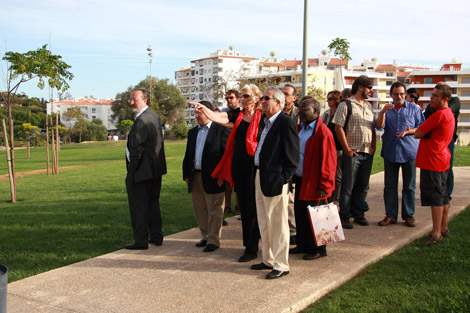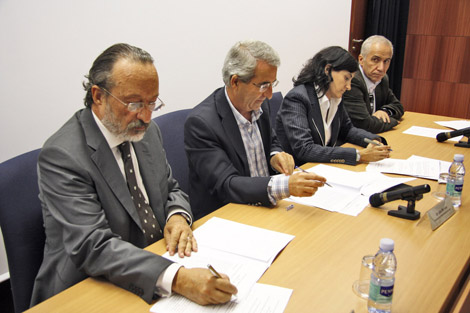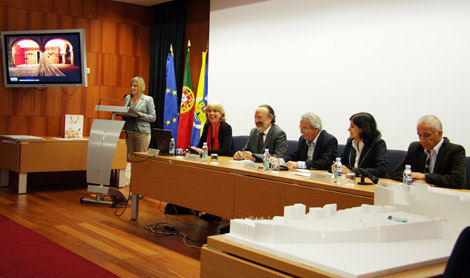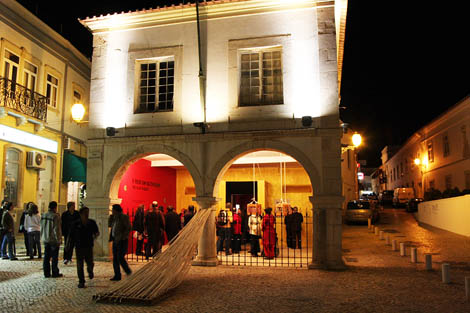 There are already installations, an architectural draft, ideas for the museological project, and a lot, a lot of will… but the main thing is missing: money. The protocol for the creation of the Slavery Museum in Lagos was signed yesterday by the City Council of this Algarve city, with the Center for Studies on Africa and Development (CEsA) and the Portuguese Committee of the UNESCO Project “The Slave Route”.
There are already installations, an architectural draft, ideas for the museological project, and a lot, a lot of will… but the main thing is missing: money. The protocol for the creation of the Slavery Museum in Lagos was signed yesterday by the City Council of this Algarve city, with the Center for Studies on Africa and Development (CEsA) and the Portuguese Committee of the UNESCO Project “The Slave Route”.
The location for this future Museum, which will be the second in Europe dedicated to the theme, after Liverpool (England), has already been chosen: one of the centers will work in the former Slave Market, in the Lagos riverside area, and the other in a building to be built in Parque do Anel Verde, where, in 2009, during the preliminary archeological interventions for the construction of a car park, what would turn out to be the oldest slave “cemetery” in the world and the only one so far discovered in Europe.
As for the Slave Market (a XNUMXth century building that will only undergo minor interior adaptations to its new functions as a museum), the architectural draft for the second nucleus, for now called «Memorial da Escravatura», was also presented this Wednesday. fair, at the same ceremony in the Câmara de Lagos that served for the signing of the protocol.
The architect Pedro Ravara is the author of the drafts for both cores of the future Slavery Museum and his presentation amazed even the mayor of Lagos: «for me, the presentation of these projects was a surprise, because I didn't know they were already so advanced», he confessed to the mayor, in the end, to the Sul Informação.

For the core of the Memorial, to be erected at the site where archaeologists found about a hundred and a half human skeletons that were later determined to be African slaves, not buried in a true cemetery, but thrown in a dump, mixed with animals, the architect Pedro Belo Ravara sketched a building that develops in two parallel bodies, one of darkness, of what was hidden and buried, in the earth and in memory, and the other of light: «a black space, from the history of this place, and another white, of bringing the investigation that was carried out to the light of contemporaneity».
Dália Paulo, regional director of Culture, present at the ceremony, highlighted the value of the Museu da Escravatura project, recalling that it was «born from archaeological research, creating a project that makes sense in Lagos and not elsewhere». "It is important that we can base everything we do in our memory and in our identity", he also underlined.
Behind this entire project for the Museum of Slavery – which will recall the fact that Lagos was, in the XNUMXth century, the first major trading post for African slaves in Europe – is the longstanding interest of the Câmara de Lagos in the subject – the president Júlio Barroso underlined the «importance of this project in our strategy» and in the affirmation of the «Lagos dos Descobrimentos brand» - but above all the great enthusiasm of Isabel Castro Henriques, president of the Portuguese Committee of the UNESCO Project “The Slave Route”.
«The Council of Lagos has been following these enthusiasms, first from Professor Rui Loureiro [member of the former Municipal Commission of Discoveries] and then from Professor Isabel Castro Henriques», recalled the mayor.
 “But when she contacted me for the first time, I immediately put everything on clean plates and told her: times are of enormous contention and the City Council doesn't have the money to build the Museum. To which she replied: there is no problem, because we will have to find the money to do this».
“But when she contacted me for the first time, I immediately put everything on clean plates and told her: times are of enormous contention and the City Council doesn't have the money to build the Museum. To which she replied: there is no problem, because we will have to find the money to do this».
But where will the money come from then? Júlio Barroso, in statements to Sul Informação, stressed that “the Chamber is not in a position to launch this project, unless through a possible funding from the pour or some candidacy that we can make for this specific type of intervention. But these are remote hypotheses». Therefore, confessed the mayor, «we are hanging at UNESCO”.
Isabel Castro Henriques, president of the Portuguese Committee of the UNESCO Project “The Slave Route”, of which the future Museum will be a fundamental part, does not hide her optimism: “we are already looking for patrons and partners” to help build the centers of the Slavery Museum in Lagos.
And who are these patrons? "Banks, construction companies, insurance companies, oil companies, companies that understand that this is an exemplary project, unique and with the seal of UNESCO", he replies. But are these Portuguese companies? Also, but not only. “We are going to look for international partnerships, not only with companies, but also with organisms”. «I have already made some démarches in this direction», namely with the Ministry of Culture of Angola and with Brazil, also revealed Isabel Castro Henriques.
 For now, for this Museum with several cores – in fact there are three, because, in addition to the Slave Market and the Slavery Memorial, there will also be a third, a Study Center, to be installed in the Manuelina window house, where the Lagos UNESCO Center – there is still no budget or deadline.
For now, for this Museum with several cores – in fact there are three, because, in addition to the Slave Market and the Slavery Memorial, there will also be a third, a Study Center, to be installed in the Manuelina window house, where the Lagos UNESCO Center – there is still no budget or deadline.
But there is already a congregation of many good wills. Isabel Castro Henriques highlights the specificities of Lagos that make this Museum unique worldwide. And it reveals the collaborations that the project has already received: firstly, from the architect Pedro Belo Ravara, who is doing the project pro bono; after several plastic artists from Portuguese-speaking countries, who donated sculptures to integrate the route of the Parque do Anel Verde, from the Gafaria gate to the Memorial da Escravatura: Chichorro (Mozambique), Lívio de Morais (Mozambique), Eduardo Male Fernandes (Saint Thomas). For now, they are, but Isabel Castro Henriques hopes to attract other plastic artists to the project, namely from Portugal, Angola, Cape Verde and Brazil.
As long as the money to carry out the physical work does not arise, the work does not stop. The protocol signed yesterday had precisely to do with the creation of the work team that will now create the museological program and the exhibition contents of the future Museum of Slavery. Even without money, there is a lot to do.


















Comments